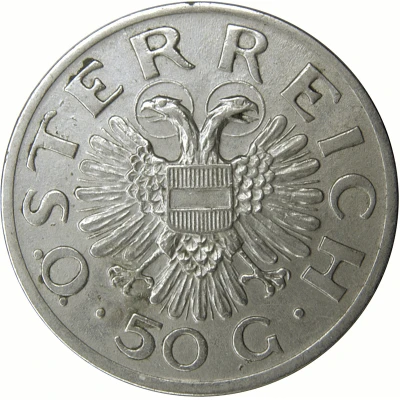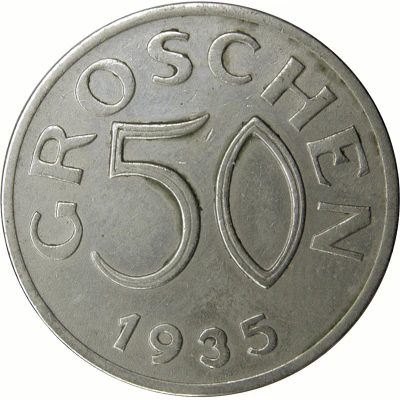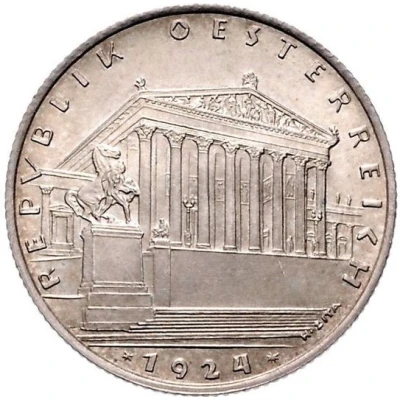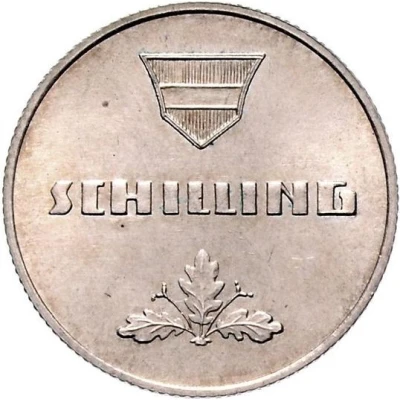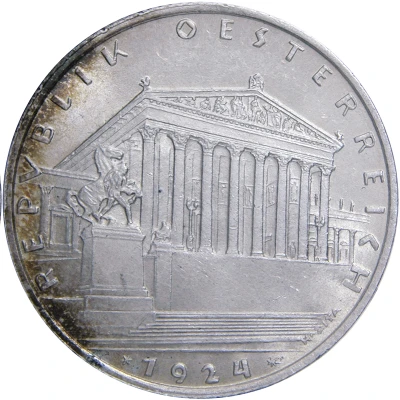
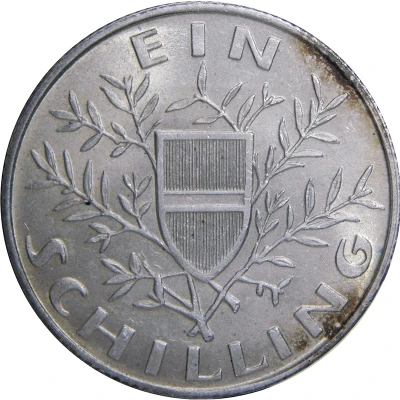

1 Schilling
1924 year| Silver (.800) | 7 g | 26 mm |
| Issuer | Austria |
|---|---|
| Period | First Republic (1919-1934) |
| Type | Standard circulation coin |
| Year | 1924 |
| Value | 1 Schilling |
| Currency | First Schilling (1925-1938) |
| Composition | Silver (.800) |
| Weight | 7 g |
| Diameter | 26 mm |
| Thickness | 1.65 mm |
| Shape | Round (80% silver, 20% copper) |
| Technique | Milled |
| Orientation | Medal alignment ↑↑ |
| Demonetized | 31 December 1926 |
| Updated | 2024-10-04 |
| Numista | N#9794 |
|---|---|
| Rarity index | 18% |
Reverse
Coat of arms of Austria. Twigs behind.
Script: Latin
Lettering:
EIN
SCHILLING
Translation: One schilling
Engraver: Heinrich Zita
Edge
Reeded
Comment
These silver schillings were the first Austrian coins of the currency reform, replacing the inflated crown (krone). The coins started to be minted before the official adoption of the schilling on 1 January 1925. As the silver coinage became a stable currency, it was colloquially known as the Alpendollar (alpine dollar).
The National Bank of Austria (Oesterreichische Nationalbank, OeNB) was founded on 14 November 1922, replacing the Austrian-Hungarian Bank (Oesterreichisch-ungarische Bank), which was in liquidation under Austrian management. The OeNB was tasked to ensure the stability of the currency and slow down inflation. At the Geneva Protocols at the end of 1922, the Seipel I federal government received a loan of 650 million gold crowns from the League of Nations and submitted to the financial control of the League of Nations. In return, Austria had to phase out printing paper money until the end of 1926 and start minting silver coinage. The value of the new silver shillings was set by law at 10 000 paper crowns, corresponding to 0.21172086 g of fine gold. Based on a law passed on 21 December 1923, Austria planned to start minting ½, 1, and 2 schilling coins (equivalent to 5000, 10 000, and 20 000 crowns) in 1924, but only the 1 schilling coins were actually issued, while ½ schilling coins only exist as patterns.
Minting of these silver 1 shilling coins started on 16 June 1924. Austria officially adopted the schilling on 1 January 1925 with the Schilling Currency Replacement Act (Schilling-Rechnungsgesetz) of 20 December 1924. The shillings were released into circulation starting on 1 March 1925, replacing the inflated crown.
The fine silver content of this first issue was very high (5.6 g) and was worth about 0.92 shillings at the time. 1 g of silver was worth circa 2.32 American cents, or 1600 Austrian crowns (0.16 shillings). Due to the high intrinsic silver value, the schilling coins were often hoarded. Consequently, the Austrian government introduced lighter schillings the following year, containing 6 g of .640 fine silver. The fine silver content of these new schillings was reduced to 3.84 g, worth circa 0.6 schillings at the time, making these coins less prone to hoarding.
Source:
Wolfgang Schmitz; 1974. “Die Krönung der Seipel-Sanierung: Der Schilling: 1924–1974”. Die Fruchte, nr. 24/15 Juni 1974, page 17.
Interesting fact
One interesting fact about the 1924 Austrian 1 Schilling coin is that it was minted during a time of economic turmoil in Austria, known as the "Inflationary Period" (1919-1924). During this time, the value of the Austrian currency, the Krone, plummeted, and the government was forced to introduce new coins with higher denominations to keep up with the inflation. The 1 Schilling coin was one of these new coins, and it was made of silver to help stabilize the currency. Despite the economic challenges, the coin remains a valuable collector's item today.
Price
| Date | Mintage | VG | F | VF | XF | AU | UNC |
|---|---|---|---|---|---|---|---|
| 1924 | 11086000 | - | - | - | - | - | - |
Values in the table are based on evaluations by sales realized on Internet platforms. They serve as an indication only for 1 Schilling 1924 coin.
